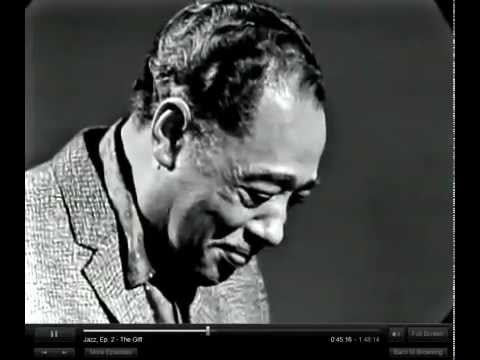Duke Ellington’s “Satin Doll” is one of the most enduring standards in jazz, a composition that radiates sophistication, charm, and elegance. Written in 1953, with music by Ellington and Billy Strayhorn and lyrics later added by Johnny Mercer, the song represents more than just a timeless melody; it captures the essence of mid-century jazz and the creative brilliance of one of the genre’s greatest figures.
Act I: The Birth of a “Doll”
By the early 1950s, Duke Ellington was already a towering figure in jazz. His partnership with Billy Strayhorn had yielded numerous masterpieces, including “Take the ‘A’ Train” and “Chelsea Bridge.” Their connections were marked by an extraordinary synergy, with Strayhorn often providing intricate harmonic structures to complement Ellington’s dynamic, improvisational energy.
“Satin Doll” emerged from this partnership as a smooth, swing-infused instrumental piece. Strayhorn’s harmonic genius is evident in the song’s complex chord progressions, particularly its use of II-V-I sequences, which would become a staple in jazz improvisation. The melody, light and playful, dances over these harmonies with an effortless grace, evoking the image of a suave, impeccably dressed figure gliding across a smoky nightclub floor.
Ellington, ever the showman, frequently used “Satin Doll” as a closing number in his live performances. Its catchy, rhythmic quality and memorable melody made it a natural choice, leaving audiences humming as they departed the venue.
Act II: Johnny Mercer Enters the Scene
While “Satin Doll” was originally conceived as an instrumental, the addition of lyrics by Johnny Mercer transformed it into a vocal standard. Mercer, a lyricist known for his clever wordplay and Southern charm, added a layer of intrigue and sophistication to the composition.
The lyrics are flirtatious and elusive, much like the titular Satin Doll herself:
“Cigarette holder, which wigs me,
Over her shoulder, she digs me…”
The imagery Mercer creates is vivid yet enigmatic, painting a picture of a glamorous, unattainable woman who exudes cool confidence. She’s not just a muse but a mystery, her allure lying in what’s left unsaid. The lyrics complement the music’s breezy swing, elevating the song’s sophistication.
Interestingly, the lyrics weren’t written with a specific narrative in mind. Instead, they serve as snapshots of moments and moods, allowing listeners to project their own interpretations onto the Satin Doll character. Is she a socialite, a femme fatale, or simply a playful figment of Ellington’s imagination? The ambiguity is part of her charm.
Act III: Satin Doll on the Stage
“Satin Doll” quickly became a staple in the jazz repertoire, performed by countless artists across generations. Vocalists like Ella Fitzgerald, Sarah Vaughan, and Frank Sinatra brought their own interpretations to the piece, each infusing it with their unique style and personality.
Ella Fitzgerald’s rendition, for example, is playful and lively, her impeccable phrasing bringing a fresh energy to Mercer’s lyrics. Sinatra’s version, on the other hand, leans into the song’s suave, romantic undertones, painting Satin Doll as the ultimate symbol of elegance and allure.
On stage, Ellington continued to use “Satin Doll” as a showcase for his orchestra. Each performance featured subtle variations, with different sections of the band taking turns to shine. The brass might accentuate the song’s rhythmic drive one night, while the woodwinds added a delicate, shimmering quality the next. This adaptability is a testament to the composition’s strength, as it thrives in both intimate and grand settings.
Act IV: Satin Doll in the Jazz Canon
What makes “Satin Doll” so timeless? Part of its magic lies in its balance of complexity and accessibility. For musicians, the song’s intricate chord changes and harmonic richness make it a rewarding challenge, offering endless possibilities for improvisation. For listeners, its infectious swing and catchy melody make it an instant favorite.
The song also captures a moment in jazz history when the genre was evolving rapidly. By the 1950s, bebop had introduced a new level of technical virtuosity to jazz, while big bands were adapting to changing tastes. “Satin Doll” bridges these worlds, combining the elegance of swing with the harmonic sophistication of modern jazz. It’s both a nod to the past and a step toward the future, embodying the ever-evolving nature of the genre.
Act V: Satin Doll in Pop Culture
Beyond the concert hall, “Satin Doll” found its way into films, television shows, and advertisements, cementing its place in popular culture. Its association with mid-century glamour and sophistication made it a natural fit for projects seeking to evoke that era’s elegance.
In one notable instance, the song appeared in Woody Allen’s 1987 film Radio Days, underscoring a scene with its nostalgic charm. Its use in such contexts speaks to its universal appeal and ability to transport listeners to another time and place.
Act VI: Legacy and Influence
Today, “Satin Doll” remains a cornerstone of the jazz canon, performed by musicians around the world. Its influence extends beyond jazz, with its chord progressions and melodic motifs inspiring artists in genres ranging from pop to classical.
For emerging jazz musicians, “Satin Doll” is often a rite of passage—a piece that introduces them to the art of swing, the intricacies of improvisation, and the importance of nuance in performance. Its enduring popularity in jam sessions and music education underscores its role as both a teaching tool and a source of inspiration.
The Timelessness of Satin Doll
Duke Ellington’s “Satin Doll” is more than just a song—it’s a story, a mood, and a masterpiece. Its creation brought together some of the greatest talents in jazz, resulting in a piece that continues to captivate audiences nearly seven decades later. Whether experienced as a lush orchestral arrangement, a soulful vocal interpretation, or a stripped-down instrumental, “Satin Doll” invites listeners into a world of elegance, mystery, and swing.
As long as there are musicians willing to interpret its harmonies and audiences eager to lose themselves in its charm, “Satin Doll” will remain a shining jewel in the crown of jazz history. Its satin sheen may age, but its allure is eternal—a testament to the genius of Duke Ellington, Billy Strayhorn, and Johnny Mercer, and their ability to create music that transcends time.
No comments yet.








